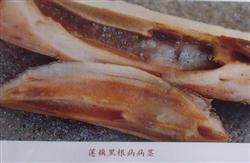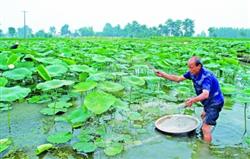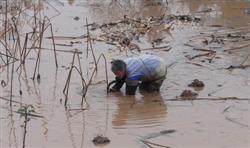What diseases should be controlled in planting lotus root?

What diseases should be controlled in planting lotus root? Please introduce that lotus root is a high-yield and high-efficiency aquatic cash crop and a vegetable variety eaten by the people. It is widely cultivated in various places. With the adjustment of local industrial structure, its cultivated area is constantly expanding. In recent years, the disease of lotus root is becoming more and more serious, which has become a major obstacle to the development of lotus root production. 1. Common diseases of lotus root 1. Lotus root rot disease is also known as black root disease and lotus root plague. It is the first major disease in lotus root production, which is easy to occur in the old lotus root field and continuous cropping field with shallow tillage layer and shallow water, which affects the lotus root and reduces the yield. It is a disease of lotus root caused by Fusarium oxysporum, which is mainly harmful to underground stem, aboveground leaf and leaf surface. The leaves of diseased stems are light green in color, brown and withered from the leaf edge, and the petiole finally withered. Most of the bacteria invaded from the wound, absorbing root or growing point, and the bacteria spread with running water irrigation. 2. The leaf blight of lotus root is the second most serious disease on lotus root, and the pathogen is the pathogenic fungus of monofilament. The main harm to the lotus leaf, the edge of the lotus leaf first appeared light yellow disease spot, and then gradually spread to the middle of the leaf, showing yellowish brown, and finally expanded from the mesophyll to the leaf vein, until the whole leaf withered. High temperature and rainy, conducive to the disease, lotus root field fertility is insufficient, the disease is serious. 3. The leaf spot of lotus root is mainly harmful to leaves, and sometimes occurs on the petiole, which is caused by pathogenic fungi of the genus Cladosporium. Second, lotus root diseases, comprehensive control 1, 2-3 years of rotation. In particular, flood-drought rotation plays an important role in reducing diseases. 2. Selecting disease-free lotus root planting lotus root with bacteria is the main bacterial source of rot disease. To prevent the disease, the key is to select healthy plant from disease-free lotus root field as seed lotus root and put an end to the bacterial source. Before planting lotus root, seed lotus root was sprayed with 50% carbendazim or methyl thiophanate 800 times solution, or 75% chlorothalonil wettable powder 800 times solution was sprayed, sealed with plastic film for 24 hours, and sown after drying. 3. Remove the diseased plant and the diseased body of the diseased lotus root field thoroughly, and bury it deeply or burn it centrally. Before planting, 50-100 kg of quicklime is applied per mu, which can not only sterilize and clean the countryside, but also accelerate the decomposition of organic fertilizer. 4. Organic fertilizer should be the main base fertilizer for rational fertilization, and the fertilizer must be fully mature. In the soil with heavy acidity and strong reducibility, lime should be re-applied, and lime should be applied early and more. During the growth period, attention should be paid to the combined application of nitrogen and phosphate fertilizer, silicon fertilizer should be added where possible, boron, zinc, molybdenum and other micro-fertilizers should be advocated, and chemical nitrogen fertilizer should not be applied to improve plant disease resistance. 5. Scientific management of deep water irrigation during the disease period to reduce the ground temperature and restrain the reproduction of bacteria. Keep the lotus field soaked in deep water every day, do not drain the water or turn to the sun in winter. Non-reserved fields all cut down lotus stalks and plough or dig lotus roots after picking lotus seeds, and it is best to plant winter crops for a season. Those who do not grow winter crops should also plough, irrigate and soak the fields to reduce the carrying of bacteria in the soil and diseased bodies. 6. timely use of drugs for prevention and treatment. At the initial stage of the disease, 50% carbendazim wettable powder was sprayed with 50% carbendazim wettable powder, or 50% carbendazim wettable powder was sprayed with 50% carbendazim wettable powder or 50% carbendazim wettable powder plus 75% chlorothalonil. You can also use the above mixture powder 500g to mix 25-30kg of fine soil, and then sprinkle it under the shallow water layer after being stuffed for 3-4 hours. After 2-3 days, you can use the 600x liquid of the above mixture or the 800x liquid of 70% methyl topazine, or the carbendazim 200x solution mixed with 4000 times of the liquid, spraying the leaf surface or petiole for 2-3 times, which can effectively reduce or control the spread of the disease. Click to get more lotus root planting techniques click to get more vegetable planting techniques
- Prev

How to apply fertilizer to plant lotus root?
How to apply fertilizer to plant lotus root? Please give guidance to plant lotus root can refer to the following methods of fertilization: lotus root growth and development is divided into three stages, namely, sprouting stage, prosperous stage and lotus root stage, sprouting stage from plant germination to standing leaves. After standing leaves, lotus root grows new roots, which mainly depends on the stored nutrients of lotus root.
- Next

How to harvest lotus root?
How to harvest lotus root? Please guide the early harvest of lotus root to affect the yield and the decline of quality too late. therefore, the harvest time should be determined according to the early or late of seedling and the need of eating. ① fragrant lotus root. The newly formed lotus root is called flower lotus root, also known as tender lotus root, this kind of lotus root starch content is very low, with fresh, tender and sweet.
Related
- Where is it suitable to grow horseradish in China? it is expected to see the middle altitude horseradish in Alishan.
- How to prevent tomato virus disease reasonably? (Control methods included)
- Many people like to plant towel gourd on the balcony. What are the main points of this method and management?
- What crops can chili peppers be mixed with?
- Fertilization techniques and matters needing attention in Tomato
- What are the grafting techniques for peach seedlings in spring?
- Harm and control methods of root swelling disease of Chinese cabbage
- What are the pests of sweet potatoes? How to prevent and cure it?
- Symptoms, causes and Control methods of navel Rot in Tomato
- The cause of "Cucumber rotten bibcock" in Farmers' planting Cucumber and its Control Plan

